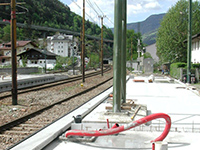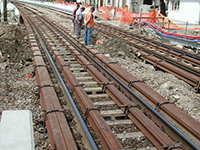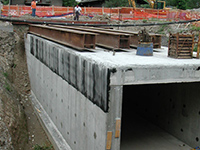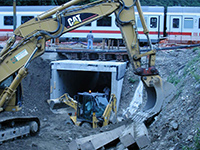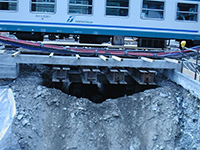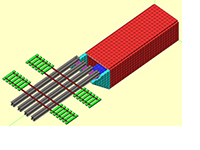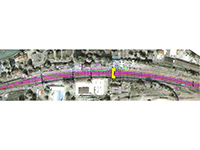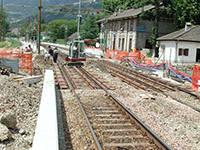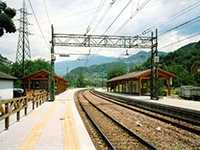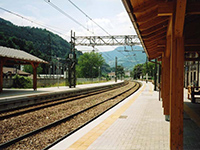Stazione di Chiusa Ferrovia del Brennero
Stazione di Chiusa (BZ) Ferrovia Verona Brennero: realizzazione sottopasso e banchine
Chiusa (BZ) Station Verona Brennero Railway: building an underpass and platforms
Committente/client: Rete Ferroviaria Italiana
Impresa/general contractor: Tor di Valle Costruzioni S.p.A.
Prestazioni/performance: progetto esecutivo – direzione tecnica / detailed design – technical management
Nel programma di potenziamento della linea ferroviaria Verona-Brennero, presso la stazione di Chiusa è stato realizzato un sottopasso viaggiatori, con uno scatolare in c.a. da porre in opera con la classica tecnica dello spingitubo, sono state ricostruite le banchine e sono state montate delle pensiline in legno lamellare. Lo scatolare in c.a. è lungo 13.60 m, ha luce netta pari a 4.10 m, ed altezza al rustico pari a 3.10 m. Il monolite è stato prefabbricato su platea di varo, ed infisso con martinetti che contrastano su un muro reggispinta. L’area di scavo per la spinta è stata ricavata entro apposite paratie in doppia fila di micropali. Il sostegno della sede ferroviaria è stato ottenuto con fasci di rotaie, tenute insieme con altre rotaie disposte trasversalmente, creando un graticcio con funzione di rinforzo e ripartizione dei carichi. Binari e fasci poggiavano sulle travi di manovra, costituite da 4 coppie di HEA 550, lunghe 13.50 m. Dette travi scaricavano le azioni prodotte dai convogli ferroviari, da un lato su una trave d’appoggio, ordita fra i rostri del monolite e, dall'altro, su un cordolo di fondazione eseguito, vicino alla linea, con castelletti di traverse. La trave d’appoggio era costituita da una coppia di HEA 450 con idonee mensole per il collegamento ai rostri.
As part of the plan for expanding the Verona-Brennero railway line, a passenger underpass was built at Chiusa station, with a reinforced concrete square tunnel, to be laid using the classic pipe ramming technique; the platforms were rebuilt and canopies in plywood were erected. The reinforced concrete square tunnel is 13.60 m long with an unencumbered span of 4.10 m and is 3.10 m high at the carcass. The monolith was prefabricated on a launch slab and fixed with jacks that contrast the thrust bearing wall. The excavation area for the thrust was created between bulkheads in two rows of micropiles. Support of the railway was created by bundles of rails, held together with other rails laid transversely, creating a trellis to act as reinforcement and distribution the weights. Tracks and bundles rested on manoeuvring beams, consisting of 4 pairs of HEA 550, 13.50 m long. Those beams discharged the actions produced by the trains, on the one hand on a support beam, stretched between the cutwaters of the monolith, and, on the other, on a foundation curb installed, near the lines, with frames of ties. The support beam consisted of a pair of HEA 450 with suitable brackets for connecting the cutwaters.
